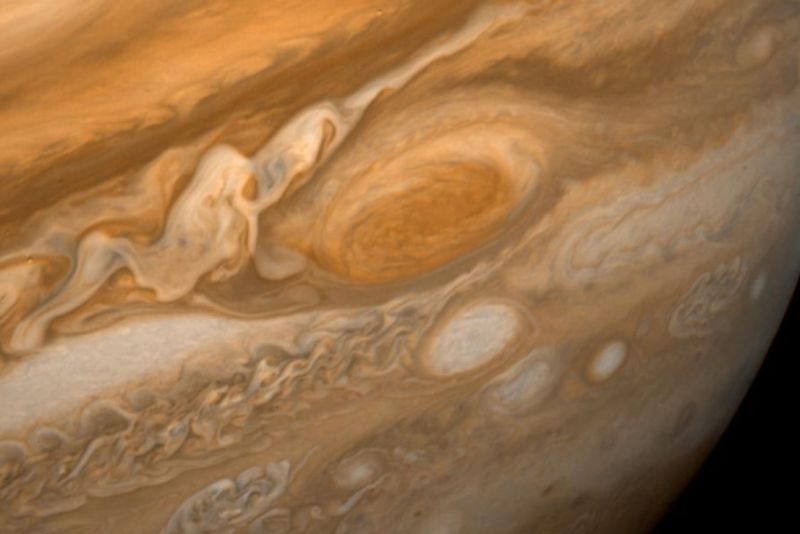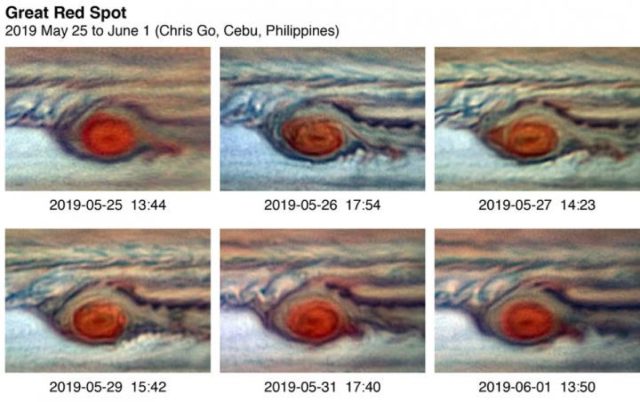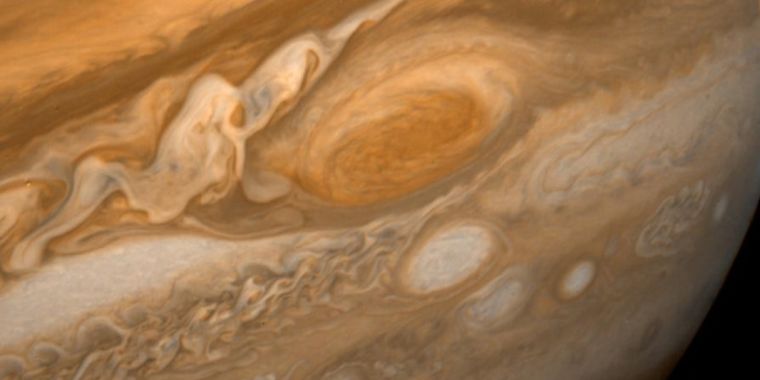
Enlarge / A dramatic view of Jupiter's Great Red Spot and its surroundings, courtesy of Voyager 1 on Feb. 25, 1979, when the spacecraft was 5.7 million miles (9.2 million kilometers) from Jupiter.
Earlier this year, several amateur astronomers spotted an unusual anomaly on the planet Jupiter: bits of the gas giant's famed Great Red Spot appeared to be flaking off, raising fears that the planet's most identifiable feature might be showing signs of disappearing. But Philip Marcus, a physicist at the University of California, Berkeley, begs to differ. He argues that reports of the red spot's death have been greatly exaggerated, offering an intriguing counter-explanation for the flaking at a meeting of the American Physical Society's Division of Fluid Dynamics in Seattle this week.
The Great Red Spot is basically a gigantic storm in Jupiter's atmosphere, about 22 degrees south of the planet's equator. Because it's located in the southern hemisphere it rotates counter-clockwise, meaning it's more of an "anti-cyclone." The 17th-century scientist Robert Hooke is commonly credited with the first recorded observation of the red spot in 1664, although some contend Giovanni Cassini provided a more convincing description in 1665. After 1713, there were no reported observations for over 100 years, until the red spot was observed again in 1830 and continually thereafter. Despite the gap in recorded observations, many astronomers believe it's the same storm, still going strong more than 350 years later.
This isn't the first time an alarm has been raised about the possible dissolution of the red spot. Back in 2004, astronomers concluded that it was shrinking, compared to 100 years ago, and the spot seems to have been shrinking even more rapidly since 2012. And in May 2017, the Gemini North telescope on the summit of Hawaii's Maunakea captured an image of a small hook-like cloud on the red spot's western side as well as a long wave, or "streamer," extending off its eastern side.
Earlier this year, the Juno spacecraft photographed large red "flakes" breaking off from the Great Red Spot. Then, on May 19, 2019, an Australian amateur astronomer named Anthony Wesley captured an image of a streamer peeling away from the red spot; he spotted the same phenomenon on May 22. Similar observations by amateur astronomers followed, variously described as "hooks" and "blades," as well as flakes and streamers.

Enlarge / A (false color) series of images capturing the repeated flaking of red clouds from the GRS in spring 2019. In the earliest image, the flaking is predominant on the east side of the giant red vortex. The flake then breaks off from the GRS, but a new flake starts to detach in the fifth image.
Chris Go
"Each streamer appears to disconnect from the Great Red Spot and dissipate," Wesley told EarthSky. "Then, after about a week, a new streamer forms and the process repeats. You have to be lucky to catch it happening; Jupiter spins on its axis every 10 hours and the Great Red Spot is not always visible."
According to Prof. Marcus, however, his computer models demonstrate that the flaking is not a death knell for the Great Red Spot at all. Rather, it's a very natural weather phenomenon arising from the complex fluid dynamics of Jupiter's atmosphere. During a press conference, he cited two specific factors that he thinks are responsible for the flaking observed earlier this year.
First, there are mergers, because an anti-cyclone like the red spot will attract other anti-cyclones while repelling regular cyclones in the atmosphere. "It's the opposite of electrical charges," he said. "Opposite charges attract and like charges repel each other." But on Jupiter, like attracts like (anti-cyclones to anti-cyclones) and opposites repel (cyclones and anti-cyclones).
There is no evidence the vortex itself has changed in size or intensity.
The process is not instantaneous. When a smaller anti-cyclone begins to merge with the red spot, it will show up as a slight bulge traveling along the outer boundary, as the red spot essentially digests it. Marcus compared it to watching a python devour a cow: "You watch the cow go through the body of the python [as it's digested], that's what happens on Jupiter." He said this kind of merger is a regular occurrence on the gas giant; every few months or so, the red spot encounters an anti-cyclone and digests it.
So what happens when a cyclone collides with an anti-cyclone that hasn't yet been fully digested by the Great Red Spot? According to Marcus, the clockwise rotation of the first and the counter-clockwise rotation of the latter can create a so-called "stagnation point," as they get close to each other. At that stagnation point, the velocity abruptly stops, restarts, and then goes off in different directions. Instead of being digested, "Everything shatters apart," said Marcus. "It's like having two fire hoses aimed at each other." Pieces of the merging anticyclone will then detach from the red spot in blades or flakes, just like those observed back in May.
Even though the flaking is not a death knell for the Great Red Spot, Marcus made a point of praising the work of amateur astronomers, since it was their constant observation of the planet that enabled them to catch this rare coincidence in the act. "They look at the red spot every single night around the world, and they were the first to detect that it was shedding red clouds," he said.
As for the observations that the Great Red Spot has been shrinking relative to a century ago, Marcus noted that the visible clouds hide the true size and nature of the vortex of the Great Red Spot. "Clouds do not equal vortices," he said. "The size of the cloud doesn't represent the size of the engine [vortex] beneath it."
And based on his computer models, there is no evidence the vortex itself has changed in size or intensity. "I think unless something cataclysmic happens on Jupiter, it will last for the indefinite future until the jet stream changes—likely centuries," said Marcus.
